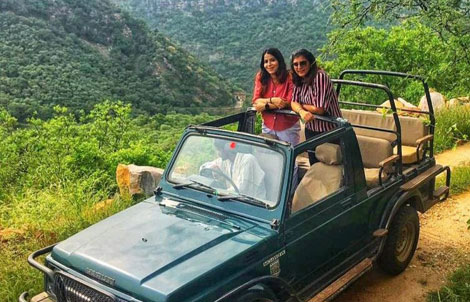
When going on a safari in Sariska Tiger Reserve or any other wildlife sanctuary, it's essential to choose appropriate clothing to ensure comfort, safety, and adherence to local norms. Here are some clothing tips to consider:
Neutral Colors Opt for neutral and earthy tones such as khaki, beige, and olive green. These colors help you blend into the natural surroundings and are less likely to disturb wildlife.
Lightweight and Breathable Fabrics Choose lightweight and breathable fabrics, especially if you are visiting during the warmer months. Cotton and moisture-wicking materials are good options to stay cool.
Long Sleeves and Pants Wear long sleeves and pants to protect yourself from the sun, insects, and any vegetation that you might come into contact with during the safari. This is particularly important in areas where there is a risk of ticks or other insects.


Hat and Sunglasses Bring a wide-brimmed hat to shield your face and neck from the sun. Sunglasses with UV protection are also recommended to protect your eyes.
Closed-toe Shoes: Wear comfortable, closed-toe shoes suitable for walking and dusty conditions. Avoid open-toed shoes to protect your feet from insects, thorns, and other potential hazards.
Jacket or SweaterEvenings and early mornings can be cooler, especially during the winter months. Bring a light jacket or sweater to stay warm during the cooler parts of the day.
Rain Gear Depending on the season, it's a good idea to carry a lightweight, waterproof jacket or poncho, as weather conditions can change unexpectedly.
Sunscreen and Insect Repellent Apply sunscreen with a high SPF to protect your skin from the sun's harmful rays. Use insect repellent to prevent insect bites, especially if you are in an area prone to mosquitoes or other biting insects.
Binoculars and Camera While not clothing, bringing binoculars and a camera with a good zoom lens is essential for wildlife viewing. It allows you to observe animals from a safe distance without disturbing them.
Respectful Attire Be mindful of the local culture and dress modestly, especially if you plan to visit nearby villages or temples. Respectful attire is important to show consideration for local customs and traditions
Always check the specific guidelines provided by the safari operators or the park authorities, as there may be additional recommendations based on the specific conditions of the reserve. Additionally, consider the season and weather conditions when planning your clothing for the safari.